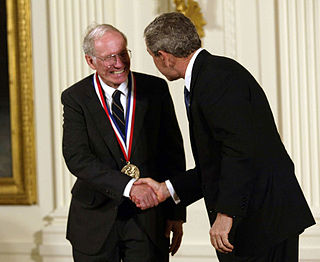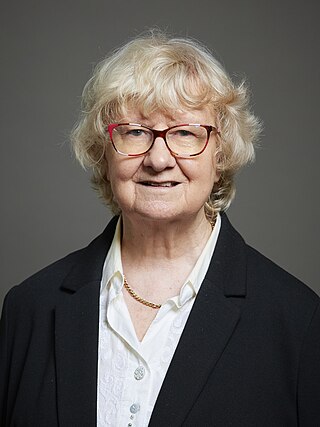Related Research Articles

Seismology is the scientific study of earthquakes and the generation and propagation of elastic waves through the Earth or other planetary bodies. It also includes studies of earthquake environmental effects such as tsunamis as well as diverse seismic sources such as volcanic, tectonic, glacial, fluvial, oceanic microseism, atmospheric, and artificial processes such as explosions and human activities. A related field that uses geology to infer information regarding past earthquakes is paleoseismology. A recording of Earth motion as a function of time, created by a seismograph is called a seismogram. A seismologist is a scientist works in basic or applied seismology.

Orogeny is a mountain-building process that takes place at a convergent plate margin when plate motion compresses the margin. An orogenic belt or orogen develops as the compressed plate crumples and is uplifted to form one or more mountain ranges. This involves a series of geological processes collectively called orogenesis. These include both structural deformation of existing continental crust and the creation of new continental crust through volcanism. Magma rising in the orogen carries less dense material upwards while leaving more dense material behind, resulting in compositional differentiation of Earth's lithosphere. A synorogenic process or event is one that occurs during an orogeny.

Geophysics is a subject of natural science concerned with the physical processes and physical properties of the Earth and its surrounding space environment, and the use of quantitative methods for their analysis. Geophysicists, who usually study geophysics, physics, or one of the Earth sciences at the graduate level, complete investigations across a wide range of scientific disciplines. The term geophysics classically refers to solid earth applications: Earth's shape; its gravitational, magnetic fields, and electromagnetic fields ; its internal structure and composition; its dynamics and their surface expression in plate tectonics, the generation of magmas, volcanism and rock formation. However, modern geophysics organizations and pure scientists use a broader definition that includes the water cycle including snow and ice; fluid dynamics of the oceans and the atmosphere; electricity and magnetism in the ionosphere and magnetosphere and solar-terrestrial physics; and analogous problems associated with the Moon and other planets.

Infrasound, sometimes referred to as low frequency sound, describes sound waves with a frequency below the lower limit of human audibility. Hearing becomes gradually less sensitive as frequency decreases, so for humans to perceive infrasound, the sound pressure must be sufficiently high. Although the ear is the primary organ for sensing low sound, at higher intensities it is possible to feel infrasound vibrations in various parts of the body.

James Norwich Arbuthnot, Baron Arbuthnot of Edrom,, is a British Conservative Party politician. He was Member of Parliament (MP) for Wanstead and Woodford from 1987 to 1997, and then MP for North East Hampshire from 1997 to 2015.

Antony Harold Newton, Baron Newton of Braintree, OBE, PC, DL was a British Conservative politician and former Cabinet member. He was the member of Parliament for Braintree from 1974 to 1997, and was later a member of the House of Lords.

Peter Robert Henry Mond, 4th Baron Melchett, also known as Peter Melchett, was an English farmer, jurist and politician. He succeeded to the title of Baron Melchett in 1973.
Ian Fells is Emeritus Professor of Energy Conversion at the University of Newcastle upon Tyne, and former chairman of the "New and Renewable Energy Centre" at Blyth, Northumberland, England.
Marine geology or geological oceanography is the study of the history and structure of the ocean floor. It involves geophysical, geochemical, sedimentological and paleontological investigations of the ocean floor and coastal zone. Marine geology has strong ties to geophysics and to physical oceanography.

Ernest Ronald Oxburgh, Baron Oxburgh, is an English geologist, geophysicist and politician. Lord Oxburgh is well known for his work as a public advocate in both academia and the business world in addressing the need to reduce carbon dioxide emissions and develop alternative energy sources as well as his negative views on the consequences of current oil consumption.

William Jason Morgan was an American geophysicist who made seminal contributions to the theory of plate tectonics and geodynamics. He retired as the Knox Taylor Professor emeritus of geology and professor of geosciences at Princeton University. He served as a visiting scholar in the Department of Earth and Planetary Sciences at Harvard University until his death.

Don Lynn Anderson was an American geophysicist who made significant contributions to the understanding of the origin, evolution, structure, and composition of Earth and other planets. An expert in numerous scientific disciplines, Anderson's work combined seismology, solid state physics, geochemistry and petrology to explain how the Earth works. Anderson was best known for his contributions to the understanding of the Earth's deep interior, and more recently, for the plate theory hypothesis that hotspots are the product of plate tectonics rather than narrow plumes emanating from the deep Earth. Anderson was Professor (Emeritus) of Geophysics in the Division of Geological and Planetary Sciences at the California Institute of Technology (Caltech). He received numerous awards from geophysical, geological and astronomical societies. In 1998 he was awarded the Crafoord Prize by the Royal Swedish Academy of Sciences along with Adam Dziewonski. Later that year, Anderson received the National Medal of Science. He held honorary doctorates from Rensselaer Polytechnic Institute and the University of Paris (Sorbonne), and served on numerous university advisory committees, including those at Harvard, Princeton, Yale, University of Chicago, Stanford, University of Paris, Purdue University, and Rice University. Anderson's wide-ranging research resulted in hundreds of published papers in the fields of planetary science, seismology, mineral physics, petrology, geochemistry, tectonics and the philosophy of science.
Alexander Dunlop Lindsay, 1st Baron Lindsay of Birker,, known as Sandie Lindsay, was a Scottish academic and peer.

Mantle convection is the very slow creep of Earth's solid silicate mantle as convection currents carry heat from the interior to the planet's surface. Mantle convection causes tectonic plates to move around the Earth's surface.

Tanya Atwater is an American geophysicist and marine geologist who specializes in plate tectonics. She is particularly renowned for her early research on the plate tectonic history of western North America.

Christopher Holmes, Baron Holmes of Richmond,, is a British former swimmer and life peer in the House of Lords. He won a total of nine gold, five silver, and one bronze medal at the Paralympic Games. Holmes represented Great Britain at four Paralympic Games between 1988 and 2000 and is the only British Paralympic swimmer to win six gold medals at a single Games.
Mary Lou Zoback is an American geophysicist and seismologist. A specialist in tectonic stress and natural hazards risks, she spent most of her career as a research scientist with the United States Geological Survey. Zoback chaired the World Stress Map project of the International Lithosphere Program from 1986 to 1992. Zoback served on the U.S. Nuclear Waste Technical Review Board from 2012 to 2018.

Rita Margaret Donaghy, Baroness Donaghy, CBE, FRSA is a British university administrator, trade unionist and Labour life peer in the House of Lords.

John "Jack" Ertle Oliver was an American scientist. Oliver, who earned his PhD at Columbia University in 1953, studied earthquakes and ultimately provided seismic evidence supporting plate tectonics. In the 1960s, Oliver and his former graduate student, Bryan Isacks, set up seismographic stations in the South Pacific to record earthquake activity, and the data collected led to the insight that part of the ocean floor was being pushed downward.
David Gubbins is a British former geophysicist concerned with the mechanism of the Earth's magnetic field and theoretical geophysics. He is Emeritus Professor of Earth Sciences at Leeds University.
References
- ↑ "Peter STYLES persona". Companies House . Retrieved 6 December 2021.
- ↑ "bgs.ac.uk" (PDF). Retrieved 22 May 2012.
- ↑ "Keele University". Archived from the original on 14 September 2011. Retrieved 8 October 2011.
- ↑ The Select Committee on Science and Technology. "Nuclear Research and Development Capabilities" (PDF). House of Lords. Retrieved 9 October 2011.
- ↑ "Saudi degrees accredited". The Geological Society. Archived from the original on 29 March 2012. Retrieved 9 October 2011.
- ↑ Peter Styles, Sam Toon. "Low Frequency Noise and Wind Turbines". RenewableUK. Retrieved 9 October 2011.